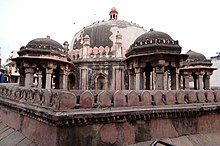

| Mubarak Shah | |
|---|---|
| Muizz-ud-Din | |

Coin of Mubarak Shah
| |
| 26th Sultan of Delhi | |
| Reign | 21 May 1421 – 19 February 1434 |
| Coronation | 1421 |
| Predecessor | Khizr Khan |
| Successor | Muhammad Shah |
| Under the nominal suzeraintyof | Shah Rukh |
| |
| Born | 1378 |
| Died | 19 February 1434 (aged 56) |
| House | Sayyid dynasty |
| Father | Sayyid khzir Khan |
| Religion | Islam |

Muizuddin Muhammad Mubarak Shah (Persian: مبارک شاهمعز الدین محمد, born Mubarak Khan; Persian: مبارک خانمعز الدین محمد; r. 1421–1434) was the second monarch of the Sayyid dynasty which ruled the Delhi Sultanate.
Sultan Mubarak Shah was the son of Khizr Khan.
He succeeded his father, Khizr Khan to the throne in 1421. Born "Mubarak Khan", he took up the regnal nameofMuizz-ud-Din Mubarak Shah or simply Mubarak Shah. The Sayyids were subservient to Timur's successor, Shah Rukh, and while Khizr Khan did not assume the title of sultan, Mubarak Shah was acknowledged as one and However, it is also known that Mubarak Shah received a robe and a chatr (a ceremonial parasol) from the Timurid capital of Herat which indicates that the fealty continued in his time. During his reign, Mubarak Shah had to deal with the rise of local dynasties in the aftermath of the Timurid invasion of India. However, the biggest threat to his power was that of Jasrat, a Muslim chieftain from Punjab who had conquered vast territories from Delhi sultanate and even aimed for Delhi in 1431. However, Jasrat retreated once Mubarak Shah marched with a large army against him.[1] Two years after this great victory however, Mubarak Shah was murdered in 1434 and succeeded by his nephew, Muhammad Shah.[2][3]
| International |
|
|---|---|
| National |
|
This biography of a member of an Indian royal house is a stub. You can help Wikipedia by expanding it. |